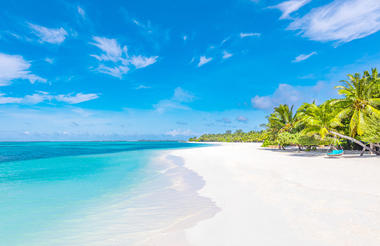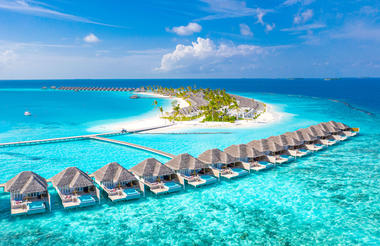Rising up from the Indian Ocean, like a colourful floating Lego town, the city of Male is one of the world's smallest national capitals. For an authentic Maldivian experience, the tiny capital packs a cultural punch. This bustling city displays a stark contrast to the rest of the tranquil sun-soaked islands that make up the Maldives. Renowned for its mosques, pretty multi-storied buildings, a popular fish and produce markets, Male is the economic heart of this tropical archipelago. Must-sees include the incredible National Museum; the golden-domed Grand Friday Mosque; and the Hukuru Miskiy Mosque, a 17th-century mosque constructed out of intricately carved white coral stones. After exploring the sights, visitors can enjoy lunch along the esplanade overlooking the impossibly turquoise waters.



The stunning little island of Rasdhoo lies in the Northern Ari Atoll (also known as Alif Alif Atoll) of the Maldives and is famous for its incredible dive sites, known as some of the best in the world. The crystalline, turquoise waters here are one of the top places to see sharks, manta rays, dolphins, turtles, and dazzling schools of brightly coloured fish. Dramatic reef walls and impressive topography add to the dreamlike scenes underwater. If you prefer staying above the surface, you’ll still have plenty to enjoy - perfect white beaches backed by lush palm groves and an array of cultural activities to keep you intrigued by this special destination. Visitors can also enjoy jet skiing, kite surfing, and wakeboarding, as well as a range of flavoursome fresh seafood dishes at some superb restaurants.
The small atoll of Rasdhoo lies off the northeastern corner of Ari Atoll proper. The atoll's main island, also called Rasdhoo, is the administrative capital of North Ari Atoll, despite not being within the natural atoll itself. Good chance to see mantas on various dive sites throughout the year. Here are some possible sites you may visit:
Madivaru (Hukrueli Faru) - Madivaru is home to a very colorful coral reef. The site is named for the abundance of manta rays seen here (Madi means manta ray in the Maldivian language Dhivehi) during the northeast monsoon season. Depths range from 25 feet to almost 100 feet, making the dive particularly interesting and varied. Manta rays are attracted to Madivaru because of the strong currents that form a whirlpool effect in the deeper parts of the site, where the manta rays can hover over the currents. The mantas are also attracted to the several cleaning stations located around Madivaru.
Hammerhead Point - Popular dive site for Maldives liveaboards. Its proximity to deep waters lends the location the best chances of getting close to these magnificent creatures. Often considered to be the highlight of many Maldives liveaboard trips.



Situated in the beautiful Maldives, North Male Atoll makes up the northern part of the larger natural Male Atoll. It is home to the city of Male which serves as the national capital of the Maldives and the transport hub of the islands. The well-developed North Male Atoll is known for its many resorts and activities. Visitors can look forward to swimming in blue lagoons, diving and snorkelling through abundant coral reefs, lazing on pristine white-sand beaches, and enjoying excellent surfing along its eastern coast which is said to have the best waves in the Maldives.
Here are some possible sites you may visit:
Lankan Manta Point - Lying along the channel reef of Lankanfushi (now Paradise Island Resort), this large block of coral is home to hundreds of cleaner wrasse. During the south west monsoon (May to November) the current runs from west to east, so the mantas feed on the outside of the eastern side of the Atolls. After they have had a feed, they come into cleaning stations such as Lankan Manta Point and get cleaned by the cleaner wrasse; a perfect chance for divers to get up close and personal with these majestic mantas.
Banana Reef: was the first dive site to be discovered in the Maldives continues to be one of the most popular. The dive, which ranges in depth from 5 to 30 meters, has several interesting characteristics including a pinnacle and some overhangs. Coral formations here are prolific and colourful, attracting an extensive variety of fish, including squirrelfish, bannerfish and oriental sweetlips. Currents can be strong at times around the reef, with occasional turbulence occurring around the overhangs. As such, the use of a surface balloon is recommended.
Kuda Haa is a dramatic pinnacle, or thila, dive, which is widely considered one of the highlights of diving in the Maldives. Diving at Kuda Haa is at its best when the currents are not strong, when it is easy to navigate between the two parts of the pinnacle. Marine life to be expected at Kuda Haa is diverse and plentiful, including many macro species, including nudibranchs, flatworms, leaf fish and frogfish.



Located in the northern Maldives, the Male Atoll consists of two separate coral atolls, North Male Atoll and South Male Atoll. South Male Atoll offers spectacular diving on its abundant coral reefs, while sun-worshippers will be in their element on its exquisite white sand beaches. It is situated conveniently close to the international airport on Male Island. Owing to the strong currents, the marine life in South Male Atoll is mostly of the larger variety, so visitors may spot eagle rays, turtles, grey sharks, reef sharks, mantas, whale sharks, schools of fusiliers, barracuda, trevally, and even hammerhead sharks (from May to November). Smaller marine life includes anemones, shrimp, lionfish, squirrelfish, soldierfish, unicornfish, morays, and batfish.
The atoll of South Male is separated from North Male by the Vaadhoo Kandu channel. Channel diving is a major feature of diving in South Male. These channels, whilst currents can be challenging, do bring with it an abundance of nutrients to feed and attract all types of marine life. Here are some possible sites you may visit: Here are some possible sites you may visit:
Kandooma Thila - A magnificent long thin pinnacle in the middle of a channel between Cocoa Corner and Kandooma Island Resort, this is one of the few channels in the Maldives where it doesn't matter which way the current is going - it will be a spectacular dive! Grey reef sharks and eagle rays are likely companions here. Due to its position in the channel, this is a dive site for advanced divers who understand the current. Magnificent overhangs with draping colourful soft coral and shark cleaning stations await those who dive this challenging but rewarding dive site.
Kuda Giri Wreck - This beautiful 30m long wreck lies along the side of a small pinnacle in South Male Atoll, sloping from 18m down to 33m at the stern. A great dive for macro lovers with the wreck having leaf fish, false-cheeked pipefish and other interesting little creatures to entertain. Explore the wreck and then work your way over to the shallow pinnacle that has an interesting overhang and little swim-throughs as well as a good coral garden at 5m where you can finish your safety stop.
Cocoa Corner (Cocoa Thila) - Cocoa Corner is a dive site that can be explored in several different ways and with the right current and conditions, it's is the best shark show around Male Atoll. Many dive guides consider crossing from Cocoa Corner to Kandooma Thila. With the right current, divers begin the dive from Cocoa Corner and while maintaining a depth of 25 to 29 metres, they swim across the current while parallel to the edge at 40 metres. This gives a natural reference that divers are maintaining the correct position while crossing to the Thila and divers are not taken too far inside the channel. The Thila lies in the middle of the channel about 15 metres from the channel edge. Here, divers will see heaps of Grey Reef Sharks from big mother sharks to newborn babies patrolling the edge of the channel together. Eagle Rays and schooling Jack Fish are also common at the beginning of the Thila. By the time divers reach the Thila, their bottom time should be running out and the best thing to do is to swim to the top of the Thila and continue diving in shallower waters. A safety balloon is a must at Cocoa Corner and divers should be prepared to make an open water safety stop.
Guraidhoo Kandu South is sometimes also known as Guraidhoo Corner. Currents at Guraidhoo Kandu are strong, making this a dive site appropriate only for advanced, experienced scuba divers. Gray reef sharks are common visitors at Guriadhoo Kandu when the currents are incoming, along with several pelagic species and eagle rays. Divers should be very cautious at this dive site, as the currents can pull you away from the reef and there is often underwater turbulence.



Encompassing over 1000 coral islands that form about 25 natural atolls, the Maldives is separated from the rest of the world by the seemingly endless Indian Ocean, offering visitors a secluded little pocket of paradise. These exquisite tropical islands are best known for their white powder sand beaches, glistening blue lagoons and extensive reefs which are home to a diverse range of colourful marine life. The nation’s bustling capital of Male features an array of charming shops and restaurants as well as a busy fish market and a must-see 17th-century mosque known as Hukuru Miskiy which was constructed out of intricately carved white coral. Visitors will find plenty of activities to keep them entertained including: scuba diving, snorkelling, water skiing, stand up paddleboarding, spa visits, and hopping from one idyllic little island to the next.



As previously described





